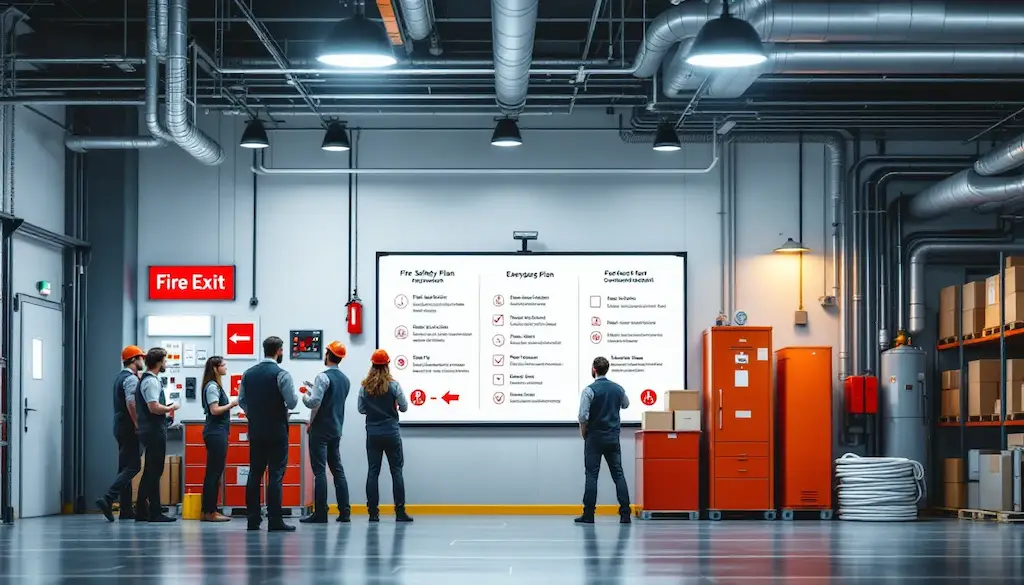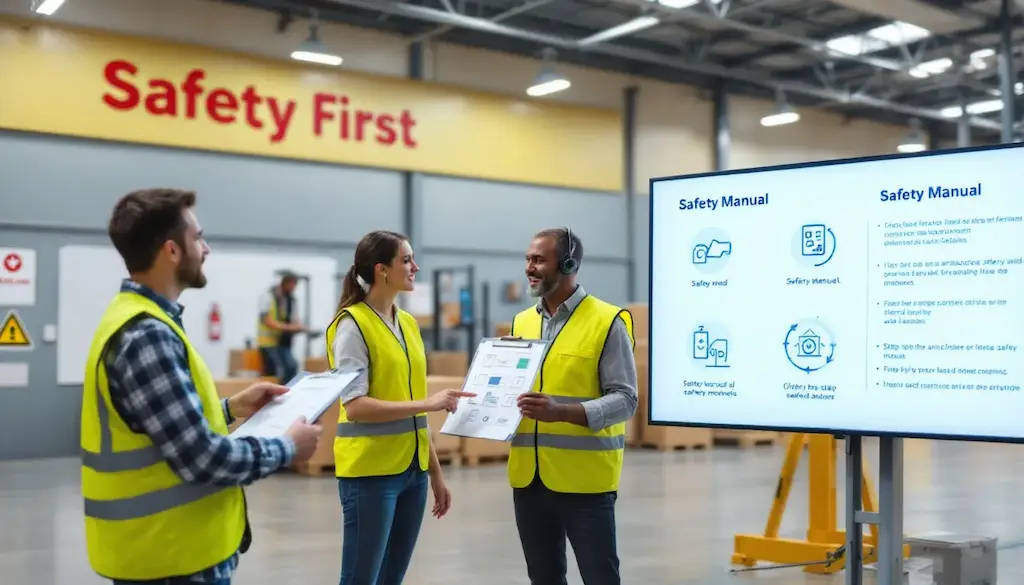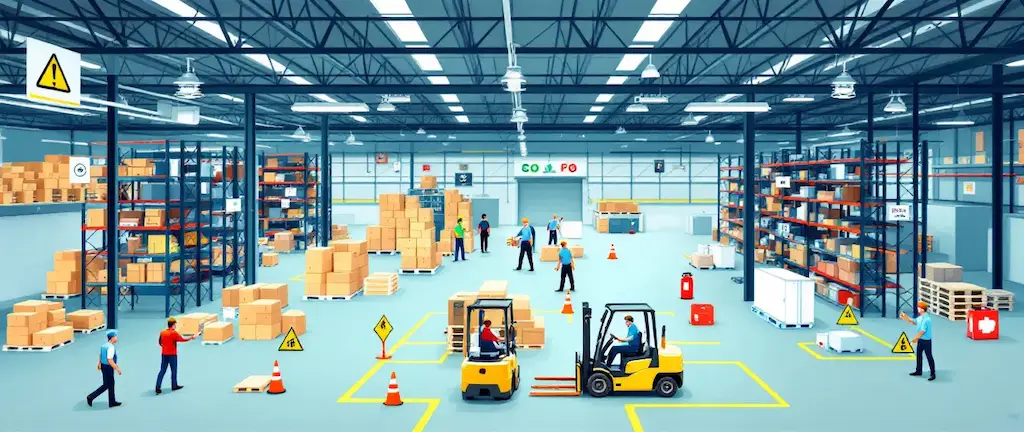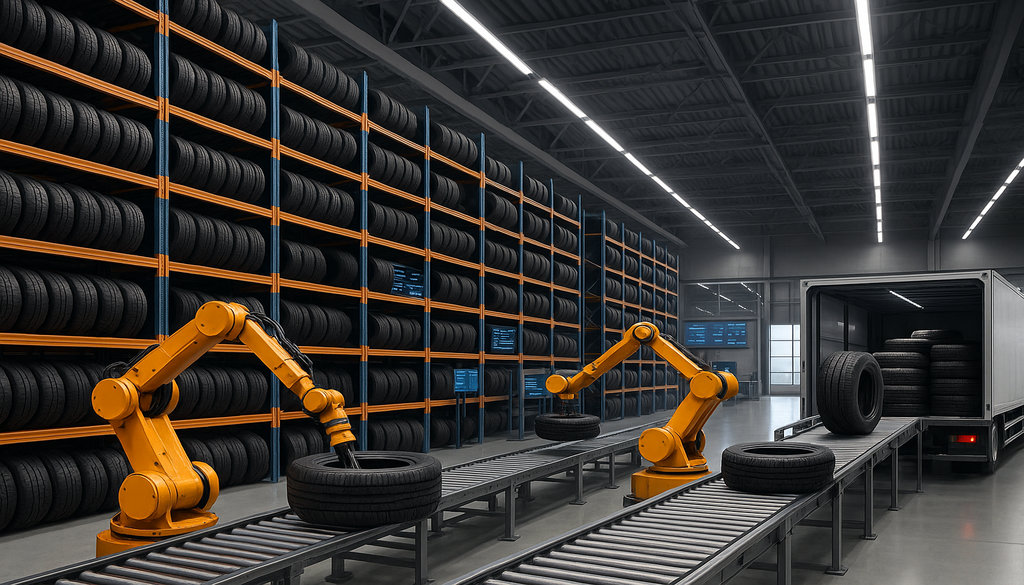How can you ensure a safe working environment in your warehouse? Warehouse safety is critical for preventing accidents and protecting workers. This article covers the top practices that every warehouse needs to implement. Read on to learn about crucial safety measures, from understanding common risks to proper lifting techniques and emergency preparedness.
Key Takeaways
- Recognizing and addressing warehouse hazards, including slips, trips, and equipment risks, is essential for preventing workplace injuries.
- Proper use and maintenance of Personal Protective Equipment (PPE) are critical to worker safety, with regular training ensuring compliance and effective protection.
- Regular safety audits, comprehensive employee training, and a clean, organized workspace significantly enhance warehouse safety and operational efficiency.
Understanding Warehouse Safety Risks
Warehouse environments are fraught with numerous hazards, many of which contribute to the industry’s disturbingly high fatal injury rates—over two times higher than in other sectors. Slips, trips, and falls alone account for 15 percent of workplace fatalities, underscoring the need for improved safety measures to address warehouse safety hazards. The risks are not just confined to these; automated tools, conveyor belts, and forklifts pose significant dangers, ranging from pinch points to the possibility of being struck by falling objects.
Recognizing these hazards is crucial for creating a safer workplace. Employers need to implement proper safety procedures and train employees to follow them. Being aware of potential risks and knowing the safest ways to perform tasks can significantly reduce accidents and injuries.
Additionally, fatigue and workplace stress increase the risk of injuries. Maintaining vigilance and fostering a safety culture can help warehouse managers turn potential incidents into near misses, effectively protecting their workers.
Importance of Personal Protective Equipment (PPE)
Personal Protective Equipment (PPE) is a cornerstone of occupational safety in warehouses, where warehouse equipment is essential for maintaining a safe working environment. PPE safeguards workers against a range of hazards, minimizing the risk of physical injuries and chronic conditions. The most common types of PPE in warehouses include safety glasses, hard hats, high-visibility vests, gloves, and steel-toe boots. Each type of PPE serves a specific purpose, from protecting against falling objects to shielding eyes from dust and debris.
The effectiveness of PPE hinges on its proper use and maintenance. Ill-fitting or poorly maintained PPE can be as hazardous as not wearing any protection at all. Hence, PPE must be readily available, and employees should be trained in its correct use and maintenance. Regular safety training sessions should highlight the importance of PPE and ensure all equipment remains in good condition.
In noisy environments, hearing protection becomes essential to prevent potential hearing loss from loud machinery. Proper fitting and maintenance of PPE, reinforced through regular reminders, can significantly enhance worker safety.
Proper Lifting Techniques to Prevent Injuries
Improper lifting techniques are a common cause of workplace injuries, leading to serious conditions such as muscle strains and back injuries. Preventing these injuries requires adopting proper lifting techniques and promoting ergonomic practices. Workers should assess the weight and awkwardness of loads and determine if mechanical aids are available to assist.
The correct lifting technique involves:
- Maintaining a straight back by tightening the abdominal muscles.
- Bending at the knees, rather than the waist.
- Utilizing the ‘power zone’ for lifting, which is between mid-thigh and mid-chest height, to reduce the risk of injury.
- Using mechanical aids like hand trucks to significantly minimize physical strain and enhance safe handling practices.
Fatigue can also impair lifting capabilities, increasing the risk of injury. Regular breaks and avoiding overexertion are crucial to maintaining safe lifting practices. Environmental factors such as temperature and visibility should also be considered, as they can affect lifting abilities and safety.
By emphasizing proper ergonomics and safe lifting techniques, warehouse managers can protect their workers from common injuries by following warehouse safety tips outlined.
Maintaining a Clean and Organized Workspace
A clean and organized workspace is fundamental to ensuring workplace safety and efficiency. Cluttered areas can lead to serious injuries due to trips and falls, making it imperative to maintain cleanliness. Regular cleaning schedules help minimize debris and hazards on the warehouse floor, significantly reducing the risk of slips, trips, and falls.
Assigning specific cleaning tasks to team members fosters a sense of responsibility and engagement in maintaining safety. Additionally, labeling storage areas clearly helps workers find items quickly, reducing unnecessary searching and potential hazards. Organizing frequently used items within easy reach also minimizes the need for climbing or stretching, which can lower the risk of falls.
Proper lighting and floor conditions are essential for preventing accidents. Poor illumination increases risks, while clean, dry floors with non-slip mats greatly enhance safety. Implementing these safety tips can improve both safety and efficiency in the workspace.
Forklift Safety Essentials

Forklifts and Powered Industrial Trucks (PITs) are integral to warehouse operations but also pose significant safety risks. Approximately 95,000 employees are injured each year while operating forklifts, highlighting the critical need for proper safety measures. Training programs should provide comprehensive instruction on safe forklift operation to ensure operators are well-equipped to handle these machines.
Implementing speed limits and clear traffic routes can significantly reduce collisions and accidents within the warehouse. It is also important for other warehouse workers to be aware of the potential hazards associated with forklifts and understand how to stay safe around these machines.
Fostering a safety culture and adhering to OSHA requirements promote safe forklift operations and protect workers.
Fire Safety Measures

Fire safety is a critical aspect of warehouse safety. Installing smoke detectors, fire extinguishers, and sprinkler systems is essential for fire prevention and response. Fire extinguishers and sprinkler systems must be readily available and properly maintained to ensure effectiveness in emergencies.
Regular fire drills ensure effective evacuation and preparedness during a fire. Clear emergency exits must be maintained to allow everyone to leave safely during a fire emergency.
An effective fire emergency plan should outline evacuation routes and designated meeting areas, ensuring that all employees are familiar with these procedures. Prioritizing fire safety can significantly reduce fire hazards and protect workers.
Effective Hazard Communication
Effective hazard communication is essential for workplace safety. It involves informing employees about the risks of hazardous substances. Safety data sheets provide crucial details regarding hazardous substances, including their health hazards and emergency procedures. These sheets must be regularly updated to reflect any changes in hazards or composition.
A well-structured hazard communication program includes a written plan, a list of hazardous substances, labeling, and safety data sheets. Employees should receive hazard communication training upon starting and at least annually.
This ongoing safety training helps prevent workplace accidents by ensuring that employees can recognize and avoid risks. Fostering a culture of safety and maintaining regular communication ensures a safer work environment.
Emergency Preparedness and Response
Emergency preparedness is essential for responding effectively to crises in the warehouse. An emergency action plan should cover various potential situations, including natural disasters and industrial incidents. Creating an emergency preparedness plan can uncover hidden hazards and mitigate the impact of disasters.
Proper emergency lighting and clear exit signs are essential for safe evacuation during emergencies. Key areas to address in an emergency preparedness plan include prevention, protection, mitigation, response, and recovery.
Conducting regular reviews and updates of the emergency plan ensures that it remains effective and relevant. Enhancing safety awareness and committing to employee well-being can minimize the impact of safety incidents.
Regular Safety Audits and Inspections

Regular safety audits and inspections are essential for maintaining a safe working environment. Conducting audits ensures compliance with regulations and enhances safety. These audits can uncover inefficiencies and potential hazards, leading to improved productivity and safety.
Frequent inspections of forklifts and the working environment are necessary to identify hazards and ensure safety. Inspections should evaluate traffic management systems to reduce vehicle and pedestrian accidents.
Using a tailored safety checklist during audits ensures comprehensive evaluations of potential hazards. Promoting a culture of safety through regular audits encourages workers to report hazards and maintain a safe environment.
Employee Training Programs
Effective training programs mitigate risks and enhance worker awareness. Training helps new employees understand safety protocols and potential workplace hazards. Continuous training ensures forklift operators remain proficient and adhere to safety practices.
Analyzing safety incident trends can guide the development of targeted training programs to mitigate risks. Diverse training methods, such as gamification, can enhance employee engagement during safety training. Mentorship programs can help new warehouse employees learn safe practices directly from experienced workers.
Fostering a well-trained workforce significantly reduces the risk of accidents and injuries in the warehouse.
Summary
The journey through warehouse safety highlights the critical practices that ensure a safer work environment. From understanding inherent risks and using PPE to proper lifting techniques, maintaining a clean workspace, and forklift safety, each element plays a crucial role in reducing workplace injuries. Fire safety measures, effective hazard communication, and emergency preparedness further enhance safety awareness and readiness.
Regular safety audits and continuous employee training programs are fundamental to fostering a culture of safety. By prioritizing these practices, warehouse managers can protect their workers and promote a robust safety culture. Remember, a safe warehouse is not just a regulatory requirement; it is a commitment to the well-being of every employee.
Safety Matters—But So Does Efficiency, Visibility, and Control
Warehouse safety is critical, but it’s just one piece of a much larger puzzle. ASC Software delivers powerful, integrated solutions—WMS, MES/MRP, and WCS—designed to help you manage the complexity of modern warehouse, manufacturing, and distribution operations.
Discover how ASC’s software can help you streamline processes, enhance safety, and drive better results. Request a demo today.
Frequently Asked Questions
Why is warehouse safety important?
Warehouse safety is essential to prevent injuries and protect workers, as the industry has high injury rates that necessitate strict safety protocols for efficient operations. Prioritizing safety safeguards both personnel and productivity.
What types of PPE are commonly used in warehouses?
Common types of PPE used in warehouses encompass safety glasses, hard hats, high-visibility vests, gloves, and steel-toe boots, each essential for protecting workers from potential hazards. Ensuring the appropriate use of this equipment is vital for maintaining safety in the workplace.
How can proper lifting techniques prevent injuries?
Using proper lifting techniques, such as keeping a straight back and bending at the knees, significantly reduces the risk of injuries like muscle strains and back problems. Implementing these methods is essential for maintaining long-term physical health.
What are the essential elements of forklift safety?
The essential elements of forklift safety include comprehensive training for operators, adherence to speed limits, established clear traffic routes, and fostering awareness of forklift hazards among all workers. Prioritizing these aspects can significantly reduce the risk of accidents in the workplace.
How can regular safety audits improve workplace safety?
Regular safety audits significantly enhance workplace safety by identifying potential hazards, ensuring regulatory compliance, and fostering a culture of safety, ultimately leading to increased productivity and reduced risks. Implementing these audits is crucial for maintaining a safe work environment.




